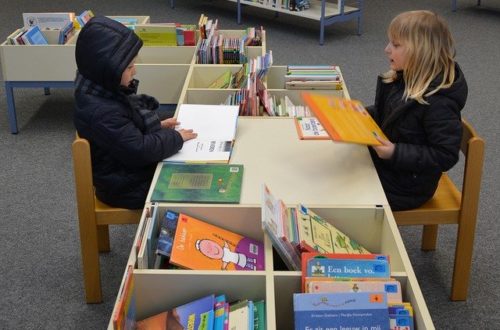Note: if you’re unfamiliar with the three-cueing system and want the full background, see this post first.
If you want the short version, it’s this: basically, the three-cueing system is derived from the observation that skilled use a variety of “clues,” including spelling, syntax, and background knowledge to draw meaning from text. Over time, that idea became profoundly distorted into the notion that children should be discouraged from using all the letters in a word to determine what it literally says, and should instead look at only the first/last letters, along with other contextual clues—usually pictures—to identify it. I’m simplifying here, but that’s the gist.
So moving on…
A couple of weeks ago, a colleague of mine attended a mandatory development workshop for AP French teachers. During a discussion of the previous year’s main essay, she learned that the average score had been exceptionally low—a 1, in fact—because so many students had confused the main verb in the prompt, s’habiller (to get dressed), with habiter (to live in or inhabit).
Now, the s’ at the beginning of the former signals a reflexive verb (in French, one literally dresses oneself), whereas habiter can never be reflexive—from a logical perspective, one cannot live in oneself, and so this construction makes no sense. (Note to anyone new to this blog: I have a college degree in French and started out tutoring that language; the English thing happened more or less by accident.)
Nevertheless, an enormous number of French AP exam-takers failed to notice either these very important linguistic clues (despite the fact that students at this level should theoretically be able to recognize reflexive constructions easily) or their commonsense implications.
Beyond that, s’habiller and habiter are such incredibly common verbs that that a student sitting for the AP exam should obviously know the difference between them.
So why did so many students mix them up?
To my colleague, who’d been following my and Emily Hanford’s work on the three-cueing system very closely, the answer seemed obvious: the main part of both verbs began with habi- and ended with -er. If students had learned to read by looking at only the beginning/end of a word and then guessing or assuming the rest (“t,” “ll,” whatever, it’s all, like, basically the same thing), then this was exactly the type of error that they would be expected to make.
My colleague knew that French teachers were generally aware of what their students weren’t learning in English class—they collectively lamented their students’ inability to write an introduction or structure a paragraph coherently—and so she thought nothing of it when she pointed out that thanks to the three-cueing system, students were being taught to focus only on the beginnings and ends of words, and to ignore the letters in the middle.
Nothing.
Blank stares.
My colleague was astonished. It was, she told me, as if no one could quite process what she was saying. The other teachers simply ignored her comment and moved on.
“Yeah,” I said matter-of-factly when she told me. “I’m not surprised. It sounds too far out there—the reality is too crazy to even contemplate. You should have said something like, ‘You know, kids spend so much time scrolling through Instagram that they don’t really read things all the way through. You have to keep reminding them to slow down and read the words carefully. That’s the kind of statement that teachers would get.’”
To me, the incident seemed to perfectly encapsulate the central problem of the whole three-cueing mess: persuading people that a problem actually exists. Because, of course, recognizing and naming a problem is the first step toward solving it; if no one believes that there is a problem—because it sounds, well, crazy—then how the heck are you supposed to get anyone to do anything about it?
As I’ve written about recently, one major roadblock is the disconnect between many early-elementary teachers and literacy coaches, who are steeped in three-cueing methodologies, and teachers of older students, who generally have not even heard of the three-cueing system. Just getting teachers on the same page in terms of what and how students are learning in younger vs. older grades would be an immense achievement (although extremely unlikely to happen, given—among many other things—the lack of physical proximity between elementary and high-school teachers in most districts). If teachers themselves do not even know where the roots of students’ problems lie, how is it fair to expect people outside the education system to figure it out?
Illuminating as they are, articles like Emily Hanford’s recent piece for American Public Media are a drop in the bucket: a recent NY Times article about the drop in 2019 NAEP reading scores elicited exactly one comment (out of hundreds) that drew a connection between the fact that many children are taught read by looking at pictures and guessing, and poor reading ability. One single comment. A really important part of the reading narrative just isn’t penetrating public consciousness.
Recently, I said only half flippantly to a colleague that the next time a major media outlet does an article on why children aren’t reading well, we need to get a group together and flood the comments section with responses pointing out that YOU CAN’T LEARN TO READ BY LOOKING AT PICTURES AND GUESSING.
Over and over and over and over.
Like any idea, this one will eventually penetrate if people just hear it repeated often enough, in enough places and in simple enough terms (small words good, big words bad).
It seems to me that if a really wrongheaded idea like the nonsense version of three-cueing could get propagated and then entrenched in a system as decentralized as the American one, then it should be possible—theoretically, at least—for a right-headed idea to become similarly entrenched. I don’t think decentralization is the real impediment here, since more or less the same set of bad ideas /practices is found pretty much everywhere.
Although I do have to wonder whether there is fact something unique in the nature of bad ideas—particularly in the internet age—that makes them more susceptible to being accepted. Most likely it’s the fact that reality tends to be complex and unwieldy, whereas falsehoods are more likely to be simple and easily digestible, and to play to laziness and petty prejudices.
If people have been conditioned to believe that environmental factors—be they social, economic, cultural, etc.— are completelyresponsible for students’ struggles in reading, and that schools can do absolutely nothing about this (as many NYT commenters, along with plenty of reporters across the political spectrum, seem to believe), then why even bother to try to fix things? I mean, is it what it is, right?
Right?





